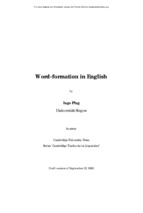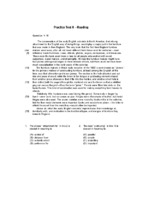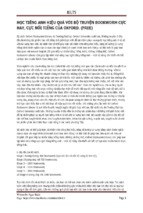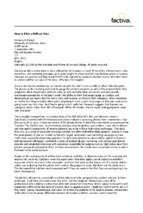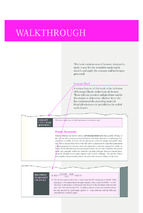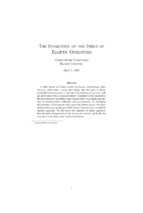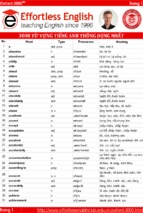Risk Management
and Simulation
K11622_FM.indd 1
5/13/13 3:08 PM
K11622_FM.indd 2
5/13/13 3:08 PM
Risk Management
and Simulation
Aparna Gupta
K11622_FM.indd 3
5/13/13 3:08 PM
MATLAB® is a trademark of The MathWorks, Inc. and is used with permission. The MathWorks does not
warrant the accuracy of the text or exercises in this book. This book’s use or discussion of MATLAB® software or related products does not constitute endorsement or sponsorship by The MathWorks of a particular
pedagogical approach or particular use of the MATLAB® software.
CRC Press
Taylor & Francis Group
6000 Broken Sound Parkway NW, Suite 300
Boca Raton, FL 33487-2742
© 2014 by Taylor & Francis Group, LLC
CRC Press is an imprint of Taylor & Francis Group, an Informa business
No claim to original U.S. Government works
Printed on acid-free paper
Version Date: 20130509
International Standard Book Number-13: 978-1-4398-3594-4 (Hardback)
This book contains information obtained from authentic and highly regarded sources. Reasonable efforts
have been made to publish reliable data and information, but the author and publisher cannot assume
responsibility for the validity of all materials or the consequences of their use. The authors and publishers
have attempted to trace the copyright holders of all material reproduced in this publication and apologize to
copyright holders if permission to publish in this form has not been obtained. If any copyright material has
not been acknowledged please write and let us know so we may rectify in any future reprint.
Except as permitted under U.S. Copyright Law, no part of this book may be reprinted, reproduced, transmitted, or utilized in any form by any electronic, mechanical, or other means, now known or hereafter invented,
including photocopying, microfilming, and recording, or in any information storage or retrieval system,
without written permission from the publishers.
For permission to photocopy or use material electronically from this work, please access www.copyright.
com (http://www.copyright.com/) or contact the Copyright Clearance Center, Inc. (CCC), 222 Rosewood
Drive, Danvers, MA 01923, 978-750-8400. CCC is a not-for-profit organization that provides licenses and
registration for a variety of users. For organizations that have been granted a photocopy license by the CCC,
a separate system of payment has been arranged.
Trademark Notice: Product or corporate names may be trademarks or registered trademarks, and are used
only for identification and explanation without intent to infringe.
Library of Congress Cataloging‑in‑Publication Data
Gupta, Aparna.
Risk management and simulation / Aparna Gupta.
pages cm
Includes bibliographical references and index.
ISBN 978-1-4398-3594-4 (alk. paper)
1. Risk management. 2. Risk management--Simulation methods. I. Title.
HD61.G86 2013
338.5--dc23
2013007014
Visit the Taylor & Francis Web site at
http://www.taylorandfrancis.com
and the CRC Press Web site at
http://www.crcpress.com
K11622_FM.indd 4
5/13/13 3:08 PM
To my parents, Amar-Sneh
Contents
I
Risk and Regulation
1 Defining Risk
1.1 Types of Risk . . . . . . . . . . . . . . . . . . . . . . . . .
1.1.0.1 Pure Risk . . . . . . . . . . . . . . . . . . .
1.1.0.2 Speculative Risk . . . . . . . . . . . . . . .
1.1.1 Classification of Pure Risk . . . . . . . . . . . . . . .
1.1.2 Classification of Speculative Risk . . . . . . . . . . .
1.2 Getting Started with Modeling Risk . . . . . . . . . . . . .
1.2.1 Random Variable and Probability . . . . . . . . . .
1.2.1.1 Summarizing Random Variables . . . . . .
1.2.1.2 Several Random Variables and Correlation
1.2.1.3 Conditional Probability . . . . . . . . . . .
1.2.2 Specific Models of Risk . . . . . . . . . . . . . . . .
1.2.2.1 Normal Distribution . . . . . . . . . . . . .
1.2.2.2 Uniform Distribution . . . . . . . . . . . .
1.2.2.3 Central Limit Theorem . . . . . . . . . . .
1.2.2.4 Binomial Distribution . . . . . . . . . . . .
1.2.2.5 Poisson Distribution . . . . . . . . . . . . .
1.2.2.6 Exponential Distribution . . . . . . . . . .
1.2.2.7 Weibull Distribution . . . . . . . . . . . . .
1.2.2.8 Lognormal Distribution . . . . . . . . . . .
1.2.2.9 Chi-Square Distribution . . . . . . . . . . .
1.2.2.10 Gamma Distribution . . . . . . . . . . . . .
1.3 MATLABr Tools for Distributions . . . . . . . . . . . . .
1.4 Summary . . . . . . . . . . . . . . . . . . . . . . . . . . . .
1.5 Questions and Exercises . . . . . . . . . . . . . . . . . . . .
.
.
.
.
.
.
.
.
.
.
.
.
.
.
.
.
.
.
.
.
.
.
.
.
3
5
5
6
7
8
12
12
14
16
17
19
19
20
21
23
23
24
26
27
27
29
30
30
31
2 Framework for Risk Management
2.1 How to Handle Risk . . . . . . . . . . . . . . . .
2.1.1 The Risk Management Framework . . . .
2.1.2 Risk Preference vs. Risk Aversion . . . . .
2.1.2.1 Normative vs. Behavioral Choice
2.1.3 Risk Measures . . . . . . . . . . . . . . .
2.1.4 Risk Management . . . . . . . . . . . . .
2.1.5 Elements of the Framework . . . . . . . .
.
.
.
.
.
.
.
35
36
37
40
43
45
48
50
.
.
.
.
.
.
.
.
.
.
.
.
.
.
.
.
.
.
.
.
.
.
.
.
.
.
.
.
.
.
.
.
.
.
.
.
.
.
.
.
.
.
vii
viii
Contents
2.1.5.1 Avoid . . . . . . . . . . . .
2.1.5.2 Mitigate . . . . . . . . . .
2.1.5.3 Transfer . . . . . . . . . . .
2.1.5.4 Keep . . . . . . . . . . . .
Example Contexts to Apply the Framework
2.2.1 Analysis Using Central Measures . .
2.2.2 Tail Analysis . . . . . . . . . . . . .
2.2.3 Scenario Analysis . . . . . . . . . . .
2.2.4 Stress Testing . . . . . . . . . . . . .
MATLAB Tools for Risk Measures . . . . .
Summary . . . . . . . . . . . . . . . . . . .
Questions and Exercises . . . . . . . . . . .
.
.
.
.
.
.
.
.
.
.
.
.
.
.
.
.
.
.
.
.
.
.
.
.
.
.
.
.
.
.
.
.
.
.
.
.
.
.
.
.
.
.
.
.
.
.
.
.
.
.
.
.
.
.
.
.
.
.
.
.
.
.
.
.
.
.
.
.
.
.
.
.
51
51
53
54
54
55
56
58
59
60
61
61
. . . . .
. . . . .
Banking
. . . . .
. . . . .
. . . . .
. . . . .
. . . . .
. . . . .
.
.
.
.
.
.
.
.
.
.
.
.
.
.
.
.
.
.
.
.
.
.
.
.
.
.
.
.
.
.
.
.
.
.
.
.
.
.
.
.
.
.
.
.
.
65
66
67
71
73
74
80
84
86
86
4 Principles of Simulation and Generating Random Variates
4.1 Principles of Simulation . . . . . . . . . . . . . . . . . . . . .
4.1.1 What Is Simulation? . . . . . . . . . . . . . . . . . . .
4.2 Random Number Generation . . . . . . . . . . . . . . . . . .
4.2.1 Linear Congruential Generator . . . . . . . . . . . . .
4.2.2 Lagged Fibonacci Generator . . . . . . . . . . . . . . .
4.3 Generation of Discrete Random Variates . . . . . . . . . . .
4.3.1 n-Outcome Random Variate . . . . . . . . . . . . . . .
4.3.2 Poisson Random Variate . . . . . . . . . . . . . . . . .
4.4 Generation of Continuous Random Variates . . . . . . . . . .
4.4.1 Inverse Transform Method . . . . . . . . . . . . . . . .
4.4.2 Acceptance-Rejection Method . . . . . . . . . . . . . .
4.4.3 Normal Random Variate . . . . . . . . . . . . . . . . .
4.4.3.1 Box-Muller Method . . . . . . . . . . . . . .
4.4.3.2 Polar-Marsaglia Method . . . . . . . . . . . .
4.4.3.3 Generation of Multi-Variate Normal . . . . .
4.4.4 Chi-Square and Other Random Variates . . . . . . . .
4.5 Testing Random Variates . . . . . . . . . . . . . . . . . . . .
4.5.1 Testing for Independence of Random Numbers . . . .
93
93
94
96
97
97
98
98
99
100
100
101
103
104
104
106
107
107
108
2.2
2.3
2.4
2.5
3 Regulations and Risk Management
3.1 Regulations Overview . . . . . . . . . . . .
3.1.1 Regulatory Evolution for Banking .
3.1.2 Regulatory Evolution for Investment
3.1.3 Regulatory Evolution for Insurance .
3.2 Regulations and Banking . . . . . . . . . .
3.3 Regulations and Investment Banking . . .
3.4 Regulations and Insurance . . . . . . . . .
3.5 Summary . . . . . . . . . . . . . . . . . . .
3.6 Questions and Exercises . . . . . . . . . . .
II
.
.
.
.
.
.
.
.
.
.
.
.
.
.
.
.
.
.
.
.
.
.
.
.
.
.
.
.
.
.
.
.
.
.
.
.
.
.
.
.
.
.
.
.
.
.
.
.
Modeling and Simulation of Risk
Contents
4.5.1.1 Shuffling Procedure . . . . . . . . . . . . . .
Testing for Correctness of Distribution . . . . . . . . .
4.5.2.1 The χ2 Goodness of Fit Test . . . . . . . . .
4.5.2.2 Kolmogorov-Smirnov Test . . . . . . . . . . .
4.6 Validation of Model . . . . . . . . . . . . . . . . . . . . . . .
4.6.1 Techniques for Model Verification . . . . . . . . . . . .
4.6.2 Techniques for Model Validation . . . . . . . . . . . .
4.7 Output Analysis . . . . . . . . . . . . . . . . . . . . . . . . .
4.7.1 Descriptive Output Analysis . . . . . . . . . . . . . .
4.7.1.1 Designing Simulation Run by Properties of Estimators . . . . . . . . . . . . . . . . . . . . .
4.7.2 Inferential Output Analysis . . . . . . . . . . . . . . .
4.8 MATLAB Tools for Simulation . . . . . . . . . . . . . . . . .
4.9 Summary . . . . . . . . . . . . . . . . . . . . . . . . . . . . .
4.10 Questions and Exercises . . . . . . . . . . . . . . . . . . . . .
4.5.2
ix
109
110
110
112
113
114
115
117
118
119
120
121
122
122
5 Modeling Risk Evolving over Time
127
5.1 Stochastic Processes . . . . . . . . . . . . . . . . . . . . . . . 127
5.2 Discrete-Time Evolution of Risk . . . . . . . . . . . . . . . . 128
5.2.1 Discrete-Time Markov Chains . . . . . . . . . . . . . . 129
5.2.2 Simple Random Walk . . . . . . . . . . . . . . . . . . 133
5.2.3 Geometric Random Walk . . . . . . . . . . . . . . . . 135
5.3 Continuous-Time Evolution of Risk . . . . . . . . . . . . . . 136
5.3.1 Continuous-Time Markov Chains . . . . . . . . . . . . 136
5.3.2 Poisson Process . . . . . . . . . . . . . . . . . . . . . . 138
5.3.3 Birth-Death Process . . . . . . . . . . . . . . . . . . . 140
5.3.4 Markov Process . . . . . . . . . . . . . . . . . . . . . . 141
5.3.5 Gaussian Process . . . . . . . . . . . . . . . . . . . . . 142
5.3.6 Brownian Motion . . . . . . . . . . . . . . . . . . . . . 144
5.3.6.1 Approximating Brownian Motion by a Random Walk . . . . . . . . . . . . . . . . . . . 145
5.3.6.2 Convergence of Random Variables . . . . . . 146
5.3.6.3 Properties of the Wiener Process . . . . . . . 147
5.3.7 Brownian Motion with Drift and Geometric Brownian
Motion . . . . . . . . . . . . . . . . . . . . . . . . . . 149
5.3.8 Additional Concepts for Stochastic Processes . . . . . 150
5.4 Modeling Correlation . . . . . . . . . . . . . . . . . . . . . . 152
5.4.1 Correlated Brownian Motion . . . . . . . . . . . . . . 152
5.4.2 Copulas for Correlation . . . . . . . . . . . . . . . . . 153
5.5 MATLAB Tools for Modeling Risk Evolving over Time . . . 156
5.6 Summary . . . . . . . . . . . . . . . . . . . . . . . . . . . . . 156
5.7 Questions and Exercises . . . . . . . . . . . . . . . . . . . . . 157
x
Contents
6 Building and Solving Models of Risk
6.1 Deterministic Financial Modeling . . . . . . . . . . . . . .
6.2 Introducing Stochasticity in the Modeling . . . . . . . . . .
6.3 Defining New Integrals . . . . . . . . . . . . . . . . . . . .
6.3.1 Ito Integral . . . . . . . . . . . . . . . . . . . . . . .
6.3.2 Properties of the Ito Integral . . . . . . . . . . . . .
6.3.3 Chain Rule of Ito Calculus - The Ito Formula . . . .
6.4 Analytical Solutions . . . . . . . . . . . . . . . . . . . . . .
6.4.1 Solving the Model Exactly . . . . . . . . . . . . . . .
6.5 Solving Models Using Simulation . . . . . . . . . . . . . . .
6.5.1 The Euler Method for Solving Differential Equations
6.5.2 Evaluating Simulation Solutions . . . . . . . . . . .
6.5.2.1 Convergence Properties of Solutions . . . .
6.5.2.2 Error Analysis - Absolute Error Criterion .
6.5.2.3 Error Analysis - Mean Error Criterion . . .
6.5.3 Higher Order Methods . . . . . . . . . . . . . . . . .
6.5.3.1 Trapezoidal Method . . . . . . . . . . . . .
6.6 Estimating Parameters . . . . . . . . . . . . . . . . . . . .
6.6.1 Geometric Brownian Motion . . . . . . . . . . . . .
6.6.2 Method of Maximum Likelihood . . . . . . . . . . .
6.6.3 Method of Quasi-Maximum Likelihood . . . . . . . .
6.6.4 Method of Moments . . . . . . . . . . . . . . . . . .
6.6.4.1 Ornstein-Uhlenbeck Process . . . . . . . .
6.7 MATLAB Tools for Building and Solving Models of Risk .
6.8 Summary . . . . . . . . . . . . . . . . . . . . . . . . . . . .
6.9 Questions and Exercises . . . . . . . . . . . . . . . . . . . .
III
.
.
.
.
.
.
.
.
.
.
.
.
.
.
.
.
.
.
.
.
.
.
.
.
.
161
161
164
166
166
168
170
171
172
175
175
180
181
181
183
186
186
188
188
189
191
192
192
193
194
194
Risk Management
7 Managing Equity Market Risk
7.1 Mitigating Equity Risk . . . . . . . . . . . . . . . . . . . . .
7.1.1 Portfolio Diversification . . . . . . . . . . . . . . . . .
7.1.1.1 Classical Mean-Variance Reward-Risk Measures . . . . . . . . . . . . . . . . . . . . . .
7.1.1.2 Dynamic Investment Strategy . . . . . . . .
7.1.2 Portfolio Optimization . . . . . . . . . . . . . . . . . .
7.1.2.1 Optimum Risk-Return Trade-Off . . . . . . .
7.1.2.2 Simulation Analysis for Portfolio Decisions .
7.2 Transferring Equity Risk . . . . . . . . . . . . . . . . . . . .
7.2.1 Option Pricing - Black-Scholes-Merton Approach . . .
7.2.1.1 Solving Black-Scholes Partial Differential Equation . . . . . . . . . . . . . . . . . . . . . . .
7.2.1.2 Estimating Option Price by Simulation . . .
7.2.1.3 Making Model Simpler - Binomial Tree Approach . . . . . . . . . . . . . . . . . . . . .
199
200
200
201
203
205
205
208
210
211
216
219
220
Contents
xi
7.2.2
7.3
7.4
7.5
7.6
Implied Volatility and Calibration for Risk-Neutral
Pricing . . . . . . . . . . . . . . . . . . . . . . . . . .
7.2.3 Sensitivity to the Parameters . . . . . . . . . . . . . .
7.2.4 Exotic Options . . . . . . . . . . . . . . . . . . . . . .
7.2.5 American Options . . . . . . . . . . . . . . . . . . . .
7.2.6 Generalizing the Models in Black-Scholes-Merton . . .
7.2.6.1 Constant Elasticity of Variance (CEV) Model
7.2.6.2 Model for Several Correlated Stocks . . . . .
7.2.6.3 Extensions in Option Pricing - Stochastic
Volatility . . . . . . . . . . . . . . . . . . . .
7.2.6.4 Large Sudden Changes in Prices - Jump Diffusion Model . . . . . . . . . . . . . . . . . .
Equity Hedging Strategies . . . . . . . . . . . . . . . . . . .
7.3.1 Static Hedging Strategies . . . . . . . . . . . . . . . .
7.3.2 Optimal Hedge Problem . . . . . . . . . . . . . . . . .
7.3.3 Dynamic Hedging Strategies . . . . . . . . . . . . . . .
MATLAB Tools for Equity and Portfolios . . . . . . . . . . .
Summary . . . . . . . . . . . . . . . . . . . . . . . . . . . . .
Questions and Exercises . . . . . . . . . . . . . . . . . . . . .
8 Managing Interest Rates and Other Market Risks
8.1 Pricing Fixed Income Instruments . . . . . . . . . . . . . . .
8.1.1 Bond Pricing . . . . . . . . . . . . . . . . . . . . . . .
8.1.2 Stochastic Interest Rate Models . . . . . . . . . . . . .
8.1.2.1 Short Rate Models . . . . . . . . . . . . . . .
8.1.2.2 Multi-Factor Interest Rate Models . . . . . .
8.1.2.3 Other Fixed-Income Instruments . . . . . . .
8.1.3 Simulation of Interest Rate Models . . . . . . . . . . .
8.2 Interest-Rate Risk Management . . . . . . . . . . . . . . . .
8.2.1 Interest-Rate Sensitivity in Fixed-Income Instruments
8.2.1.1 Bond Portfolio Immunization . . . . . . . . .
8.2.2 Interest-Rate Derivatives . . . . . . . . . . . . . . . .
8.2.3 Interest-Rate Hedging Strategies . . . . . . . . . . . .
8.3 Managing Commodities Risk . . . . . . . . . . . . . . . . . .
8.3.1 Modeling Commodity Spot Prices . . . . . . . . . . .
8.3.1.1 Energy, Electricity, and Weather Risk . . . .
8.3.2 Management of Commodity Risk . . . . . . . . . . . .
8.3.2.1 Commodity Futures and Other Derivatives .
8.4 Managing Foreign Exchange Risk . . . . . . . . . . . . . . .
8.4.1 Models for Spot and Forward Exchange Rates . . . . .
8.4.2 Currency Derivatives . . . . . . . . . . . . . . . . . . .
8.5 Value-at-Risk and Stress Testing for Market Risk Management
8.6 MATLAB Tools for Fixed Income, Commodities, and Exchange
Rates . . . . . . . . . . . . . . . . . . . . . . . . . . . . . . .
8.7 Summary . . . . . . . . . . . . . . . . . . . . . . . . . . . . .
223
225
229
233
235
236
237
239
244
246
247
253
254
258
258
259
265
266
266
270
270
276
277
279
280
281
285
287
291
294
297
299
301
304
306
309
310
312
317
318
xii
Contents
8.8
Questions and Exercises . . . . . . . . . . . . . . . . . . . . .
318
9 Credit Risk Management
9.1 Retail Credit Risk . . . . . . . . . . . . . . . . . . . . . . . .
9.1.1 Measuring Retail Credit Risk . . . . . . . . . . . . . .
9.1.1.1 Credit Scoring Methods . . . . . . . . . . . .
9.1.2 Retail Credit Risk Management . . . . . . . . . . . . .
9.2 Commercial Credit Risk . . . . . . . . . . . . . . . . . . . . .
9.2.1 Credit Rating System . . . . . . . . . . . . . . . . . .
9.2.1.1 Risk Assessment by Credit Rating Migration
9.2.2 Models for Credit Risk . . . . . . . . . . . . . . . . . .
9.2.2.1 Structural Model of Credit Risk . . . . . . .
9.2.2.2 Reduced-Form Model of Credit Risk . . . . .
9.3 Credit Risk Hedging Instruments . . . . . . . . . . . . . . .
9.3.1 Single-Name Credit Derivatives . . . . . . . . . . . . .
9.3.1.1 Credit Default Swaps . . . . . . . . . . . . .
9.3.1.2 Spread Options . . . . . . . . . . . . . . . . .
9.3.2 Multi-Name Credit Derivatives . . . . . . . . . . . . .
9.3.2.1 Collateralized Debt Obligations . . . . . . .
9.4 Portfolio Credit Risk Management . . . . . . . . . . . . . . .
9.5 MATLAB Tools for Credit Risk . . . . . . . . . . . . . . . .
9.6 Summary . . . . . . . . . . . . . . . . . . . . . . . . . . . . .
9.7 Questions and Exercises . . . . . . . . . . . . . . . . . . . . .
325
326
329
332
336
340
341
342
347
348
350
351
354
355
357
357
358
361
364
364
365
10 Strategic, Business, and Operational Risk Management
371
10.1 Strategic Risk Management . . . . . . . . . . . . . . . . . . . 371
10.1.1 Objective of Strategic Risk Management . . . . . . . . 373
10.1.2 Approaches for Strategic Risk Management . . . . . . 374
10.2 Business Risk Management . . . . . . . . . . . . . . . . . . . 378
10.3 Asset-Liability Management . . . . . . . . . . . . . . . . . . 380
10.3.1 Components of Asset-Liability Management . . . . . . 382
10.3.2 Risk Management in ALM . . . . . . . . . . . . . . . 385
10.3.2.1 Gap Analysis . . . . . . . . . . . . . . . . . . 385
10.3.2.2 Cumulative Gap Analysis . . . . . . . . . . . 387
10.3.2.3 Duration Gap Analysis and Gap Convexity . 387
10.3.2.4 Dynamic Gap and Long-Term Value at Risk
Analysis . . . . . . . . . . . . . . . . . . . . 388
10.3.2.5 Scenario Analysis and Stress Testing . . . . . 390
10.4 Operational Risk Management . . . . . . . . . . . . . . . . . 391
10.4.1 Assessing Operational Risk . . . . . . . . . . . . . . . 393
10.4.2 Managing Operational Risk . . . . . . . . . . . . . . . 395
10.4.2.1 Risk Measures for Operational Risk . . . . . 396
10.4.2.2 Operational Risk Management Strategy . . . 397
10.5 Summary . . . . . . . . . . . . . . . . . . . . . . . . . . . . . 399
10.6 Questions and Exercises . . . . . . . . . . . . . . . . . . . . . 399
Contents
xiii
11 Risk Management Using Insurance
11.1 Basic Concepts of Insurance . . . . . . . . . . . . . . . . . .
11.2 Principle behind Insurance . . . . . . . . . . . . . . . . . . .
11.2.1 Characteristics of Insurance and Insurable Risk . . . .
11.2.1.1 Law of Large Numbers . . . . . . . . . . . .
11.2.1.2 Requirement of Insurable Risk . . . . . . . .
11.3 Types of Insurance . . . . . . . . . . . . . . . . . . . . . . .
11.3.1 Benefits and Cost of Insurance to Society . . . . . . .
11.4 Risk Management Framework for Pure Risk . . . . . . . . .
11.4.1 Pure Risk Evaluation . . . . . . . . . . . . . . . . . .
11.4.2 Risk Management Strategies for Pure Risk . . . . . .
11.4.3 Modeling Individual Mortality Risk . . . . . . . . . .
11.5 Risk Management by Insurers . . . . . . . . . . . . . . . . .
11.5.1 Pricing, Investment, and Asset-Liability Management
11.5.2 Risk Management, Securitization, and Reinsurance . .
11.6 Summary . . . . . . . . . . . . . . . . . . . . . . . . . . . . .
11.7 Questions and Exercises . . . . . . . . . . . . . . . . . . . . .
IV
405
407
409
410
410
413
414
416
417
420
423
426
427
427
431
433
434
Advanced Simulation
12 Advanced Simulation Topics
12.1 Variance Reduction Techniques . . . . . . . . . . . . . . .
12.1.1 Control Variates . . . . . . . . . . . . . . . . . . .
12.1.2 Antithetic Variables . . . . . . . . . . . . . . . . .
12.1.3 Stratified Sampling . . . . . . . . . . . . . . . . . .
12.1.4 Latin Hypercube Sampling . . . . . . . . . . . . .
12.1.5 Importance Sampling . . . . . . . . . . . . . . . .
12.2 Simulation-Based Optimization . . . . . . . . . . . . . . .
12.2.1 Challenges of Simulation-Based Optimization . . .
12.2.2 Simulation Optimization Methodologies . . . . . .
12.2.2.1 Gradient-Based Methods . . . . . . . . .
12.2.2.2 Simulated Annealing . . . . . . . . . . . .
12.2.2.3 Tabu Search . . . . . . . . . . . . . . . .
12.2.2.4 Scatter Search . . . . . . . . . . . . . . .
12.2.2.5 Evolutionary Strategies . . . . . . . . . .
12.2.2.6 Particle Swarm Optimization . . . . . . .
12.3 MATLAB Tools for Variance Reduction and Optimization
12.4 Summary . . . . . . . . . . . . . . . . . . . . . . . . . . .
12.5 Questions and Exercises . . . . . . . . . . . . . . . . . . .
.
.
.
.
.
.
.
.
.
.
.
.
.
.
.
.
.
.
.
.
.
.
.
.
.
.
.
.
.
.
.
. .
. .
441
442
444
447
450
453
454
455
458
460
463
464
466
467
467
469
471
471
472
Bibliography
479
Index
485
List of Figures
1.1
1.2
Classification structure for types of risk. . . . . . . . . . . . .
(a) Probability density function for normal distribution. (b)
Cumulative distribution function for normal distribution. . .
1.3 (a) Probability density function for uniform distribution. (b)
Cumulative distribution function for uniform distribution. . .
1.4 Display of Central Limit Theorem. (a) N = 1,000 (b) N = 5,000
(c) N = 10,000 (d) N = 100,000. . . . . . . . . . . . . . . . .
1.5 (a) Probability mass function for binomial distribution. (b) Cumulative distribution function for binomial distribution. . . .
1.6 (a) Probability mass function for Poisson distribution. (b) Cumulative distribution function for Poisson distribution. . . . .
1.7 (a) Probability density function for exponential distribution.
(b) Cumulative distribution function for exponential distribution. . . . . . . . . . . . . . . . . . . . . . . . . . . . . . . . .
1.8 (a) Probability density function for Weibull distribution. (b)
Cumulative distribution function for Weibull distribution. . .
1.9 (a) Probability density function for lognormal distribution. (b)
Cumulative distribution function for lognormal distribution. .
1.10 (a) Probability density function for Chi-square distribution. (b)
Cumulative distribution function for Chi-square distribution.
1.11 (a) Probability density function for gamma distribution. (b)
Cumulative distribution function for gamma distribution. . .
2.1
2.2
2.3
2.4
2.5
The overall flowchart for the Risk Management Process. . . .
(a) Plot of the exponential, constant absolute risk aversion
(CARA) utility function. (b) Plot of the power, constant relative risk aversion (CRRA) utility function. . . . . . . . . . . .
Plot of the loss-aversion utility, an example of behavioral utility
function. . . . . . . . . . . . . . . . . . . . . . . . . . . . . . .
Display of Value-at-Risk and Conditional Value-at-Risk. . . .
(a) Plot of mean and standard deviation of combined risk for a
range of weights on two individual risks. (b) Plot of mean and
first percentile of combined risk for a range of weights on two
individual risks, assuming normal distribution of combined risk.
7
20
21
22
23
24
25
26
27
28
29
38
42
44
47
52
xv
xvi
List of Figures
2.6
2.7
2.8
3.1
4.1
4.2
4.3
4.4
4.5
4.6
4.7
4.8
4.9
5.1
5.2
5.3
5.4
5.5
5.6
(a) Unimodal distribution of risk and its central tendencies. (b)
Bimodal distribution of risk. . . . . . . . . . . . . . . . . . . .
Probability density plot displaying light-tail and heavy-tail. .
(a) Probability plot for a dataset that matches the light-tailed
normal distribution model. (b) Probability plot for a dataset
that displays heavy-tail deviations from the normal distribution
model. . . . . . . . . . . . . . . . . . . . . . . . . . . . . . . .
58
The table shows the main regulatory agencies for the Group
of Eight (G8) countries for banking, investment banking, and
insurance industry, as of 2012. . . . . . . . . . . . . . . . . . .
67
The guideline for how to structure a simulation study. . . . .
The stages to build the simulation model. . . . . . . . . . . .
N-outcome discrete random variate generation. . . . . . . . .
A pictorial depiction of the principle behind the inverse transform method. . . . . . . . . . . . . . . . . . . . . . . . . . . .
A pictorial depiction of the principle behind the acceptancerejection method. . . . . . . . . . . . . . . . . . . . . . . . . .
A pictorial depiction of the construction of the Polar-Marsaglia
method. . . . . . . . . . . . . . . . . . . . . . . . . . . . . . .
Display of output from a linear congruential generator. (a) 1000
numbers generated lie on three parallel lines. (b) The 1000 numbers after implementing shuffling. . . . . . . . . . . . . . . . .
Display of Probability Plots. (a) Lognormal probability plot.
(b) Weibull probability plot. . . . . . . . . . . . . . . . . . . .
Display of Validation Cost vs. Risk Cost Curve. . . . . . . . .
(a) A typical sample realization for a discrete-time stochastic process. (b) The binomial tree example of a discrete time
stochastic process. . . . . . . . . . . . . . . . . . . . . . . . .
A pictorial depiction of states of a Markov chain, transitions
following Markovian property, and transition probabilities. . .
(a) Three realizations of a simple random walk. (b) Three realizations of simple symmetric random walk. (c) Three realizations of general random walk. (d) Three realizations of simple
random walk with upper barrier set at 10. . . . . . . . . . . .
Three sample path realizations of a Poisson process with varied
levels of λ. . . . . . . . . . . . . . . . . . . . . . . . . . . . . .
(a) Three sample path realizations of an Ornstein-Uhlenbeck
process. (b) Three sample path realizations of OrnsteinUhlenbeck process with different risk levels. . . . . . . . . . .
Three sample path realizations for the standard Brownian motion or the Wiener process. . . . . . . . . . . . . . . . . . . .
55
57
95
96
99
101
102
105
108
110
116
129
130
134
139
143
145
List of Figures
5.7
5.8
6.1
6.2
6.3
6.4
7.1
7.2
7.3
7.4
7.5
7.6
(a) Three sample path realizations for the standard Brownian
motion or Wiener process with drift. (b) Three sample path
realizations for geometric Brownian motion. . . . . . . . . . .
(a) Marginal CDF for first random variable, chosen to be beta
distribution with parameters, a=2, b=2. (b) Marginal CDF for
second random variable, chosen to be Weibull distribution with
parameters, a=0.15, b=0.8. (c) Scatter plot of 1000 random
variates generated by Gaussian copula with ρ = 0.7. (d) Scatter
plot of 100 random variates generated using t-copula with ρ =
0.7, ν = 1. . . . . . . . . . . . . . . . . . . . . . . . . . . . . .
Applying different frequency of interest rate accrual for a riskfree investment. (a) Annual accrual applied for five years. (b)
Monthly accrual applied for five years. (c) Daily accrual applied
for five years. (d) Hourly accrual applied for five years. . . . .
Comparison of exact and numerical solutions for an example
ordinary differential equation. . . . . . . . . . . . . . . . . . .
Comparison of exact and numerical solution for an example
stochastic differential equation. . . . . . . . . . . . . . . . . .
Comparison of distributional properties of the exact solution
(in left panel) and numerical solution (in the right panel) for
the example stochastic differential equation. . . . . . . . . . .
Plot of risk-reward trade-off of individual stocks. The combination of the individual stock helps mitigate the risk in the
frontier. . . . . . . . . . . . . . . . . . . . . . . . . . . . . . .
Plot of mean and standard deviation of two stock returns. The
correlation of ρ = 1 and −1 define the right and left extents of
the region, respectively. . . . . . . . . . . . . . . . . . . . . .
Plot of mean and standard deviation space spanned by return
on portfolio of stocks. For a choice of expected portfolio return
threshold, the optimum risk-return trade-off is made on the
left most feasible points. The dashed curve is the efficient riskreturn trade-off points, or the efficient frontier. . . . . . . . .
Simulation analysis of risk-reward of a portfolio based on equity
returns scenarios and parametric scenarios. . . . . . . . . . .
(a) Display of pay-off and profit curve for a plain-vanilla European call option with strike price, K=$80. (b) Display of pay-off
and profit curve for a plain-vanilla European put option with
strike price, K=$80. . . . . . . . . . . . . . . . . . . . . . . .
(a) Display of pay-off and profit curve for a short position in
a plain-vanilla European call option with strike price, K=$80.
(b) Display of pay-off and profit curve for a short position in a
plain-vanilla European put option with strike price, K=$80. .
xvii
150
155
163
176
178
179
201
204
207
209
212
213
xviii
7.7
7.8
7.9
7.10
7.11
7.12
7.13
7.14
7.15
7.16
7.17
7.18
7.19
7.20
7.21
7.22
8.1
List of Figures
(a) Display of pay-off and price curve for a plain-vanilla European call option with strike price, K=$35, σ = 23%, T −t = 1/2
year, and short-term interest rate of r = 2%. (b) Display of payoff and price curve for a plain-vanilla European put option with
the same set of parameters as the call option. . . . . . . . . .
(a) Single period binomial tree model for stock price evolution.
(b) Multi-period binomial tree model for stock price evolution.
Implied volatility obtained from the Black-Scholes option pricing formula for plain-vanilla European call option with stock
price, St =$35, σ = 23%, T − t = 1/2 year, and short-term
interest rate of r = 2%. . . . . . . . . . . . . . . . . . . . . .
The chart marks the dependence of European and American
vanilla call and put option prices on parameters that determine
the price. . . . . . . . . . . . . . . . . . . . . . . . . . . . . .
Trajectories for valuation of a compound option. . . . . . . .
Pay-offs of an up-and-out barrier call option and a down-and-in
barrier call option. . . . . . . . . . . . . . . . . . . . . . . . .
Pictorial display of algorithm to determine the price of an
American option using the binomial tree model. . . . . . . . .
Monthly observations of VIX index from January 2005 through
mid-2012. The variability in the stock market is captured in
this index through the financial crises of 2008 and euro crisis
evolving through 2011-2012. . . . . . . . . . . . . . . . . . . .
(a) Profit and individual positions of a protective put. (b) Profit
and individual positions of a reverse protective put. . . . . . .
(a) Profit and individual positions of a covered call. (b) Profit
and individual positions of a reverse covered call. . . . . . . .
(a) Profit and individual positions of a bull spread using call
options. (b) Profit and individual positions of a bear spread
using put options. . . . . . . . . . . . . . . . . . . . . . . . .
(a) Profit and individual positions of a butterfly spread. . . .
(a) Profit and individual positions of a straddle. (b) Profit and
individual positions of a strangle. . . . . . . . . . . . . . . . .
(a) Profit and individual positions of a strip. (b) Profit and
individual positions of a strap. . . . . . . . . . . . . . . . . .
The points of time along the life of an option when trades must
be made to cover the naked short call position. A margin around
the strike, K, is created of width 2ϵ to avoid rapid trades when
the option is near at-the-money range. . . . . . . . . . . . . .
Delta hedge strategy takes advantage of the fact that the slope
of the option price curve will converge to the terminal pay-off
level as option reaches its maturity. . . . . . . . . . . . . . . .
Cash flow from a bond with maturity, T years, and annual
coupon of c%. . . . . . . . . . . . . . . . . . . . . . . . . . . .
218
221
225
226
229
230
234
240
248
248
249
251
252
252
255
256
266
List of Figures
8.2
8.3
8.4
8.5
8.6
8.7
8.8
8.9
8.10
8.11
8.12
8.13
8.14
8.15
8.16
9.1
9.2
Different shapes of the term structure of interest rate by maturity. (a) Constant (b) Upward sloping (c) Inverted. . . . . . .
Relation of the forward curve to the spot curve for different
shapes of the term structure of interest rates. . . . . . . . . .
Bond price as a function of increasing yield. . . . . . . . . . .
Value at Risk (VaR) and Conditional Value at Risk (CVaR)
display for bond price. . . . . . . . . . . . . . . . . . . . . . .
Volume of over-the-counter (OTC) interest rate derivatives in
2008-2010 period (Courtesy Bank for International Settlements
(BIS) Report). . . . . . . . . . . . . . . . . . . . . . . . . . .
Prices for some commodities of different type, from January
2002 through 2012. . . . . . . . . . . . . . . . . . . . . . . . .
Level of volatility in commodity indices (Courtesy Reserve
Bank for Australia (RBA) Bulletin, June 2011). . . . . . . . .
Participation in commodities markets for diversification benefits (Courtesy Reserve Bank for Australia (RBA) Bulletin, June
2011). . . . . . . . . . . . . . . . . . . . . . . . . . . . . . . .
Sample of key exchanges for developed and emerging economy
countries from all continents, as of March 2012. . . . . . . . .
United States turnover of foreign exchange, all currencies.
(Courtesy Federal Reserve Bank of New York (FRB NY) Report, April 2010). . . . . . . . . . . . . . . . . . . . . . . . . .
USD and euro daily foreign exchange volume by currency.
(Courtesy Federal Reserve Bank of New York (FRB NY) Report, April 2010). . . . . . . . . . . . . . . . . . . . . . . . . .
Spot and forward exchange rates hold a key relationship. . . .
Daily turnover comparison for foreign exchange spot, forward
and swaps. (Courtesy Federal Reserve Bank of New York (FRB
NY) Report, April 2010). . . . . . . . . . . . . . . . . . . . .
Distribution of the change in portfolio value, ∆Π, in order to
compute Market Value-at-Risk. . . . . . . . . . . . . . . . . .
Histogram and normal probability plot of two years of equity
return for Microsoft (MSFT) and Exxon-Mobil (XOM). . . .
Distribution of the population by their credit score, as well as
distribution of individuals who have defaulted and who have
not defaulted on their loans by their credit score. The figure
also indicates a selected cut-off score, with its implication on
false ‘bads’ and false ‘goods.’ . . . . . . . . . . . . . . . . . .
Level of accuracy in a specific credit scoring model relative
to a perfect and a random model. This is summarized in the
accuracy ratio, which is the area under the curve below the
actual model profile relative to the perfect model profile. . . .
xix
267
270
282
285
288
295
296
302
307
308
309
310
311
312
315
335
338
- Xem thêm -


